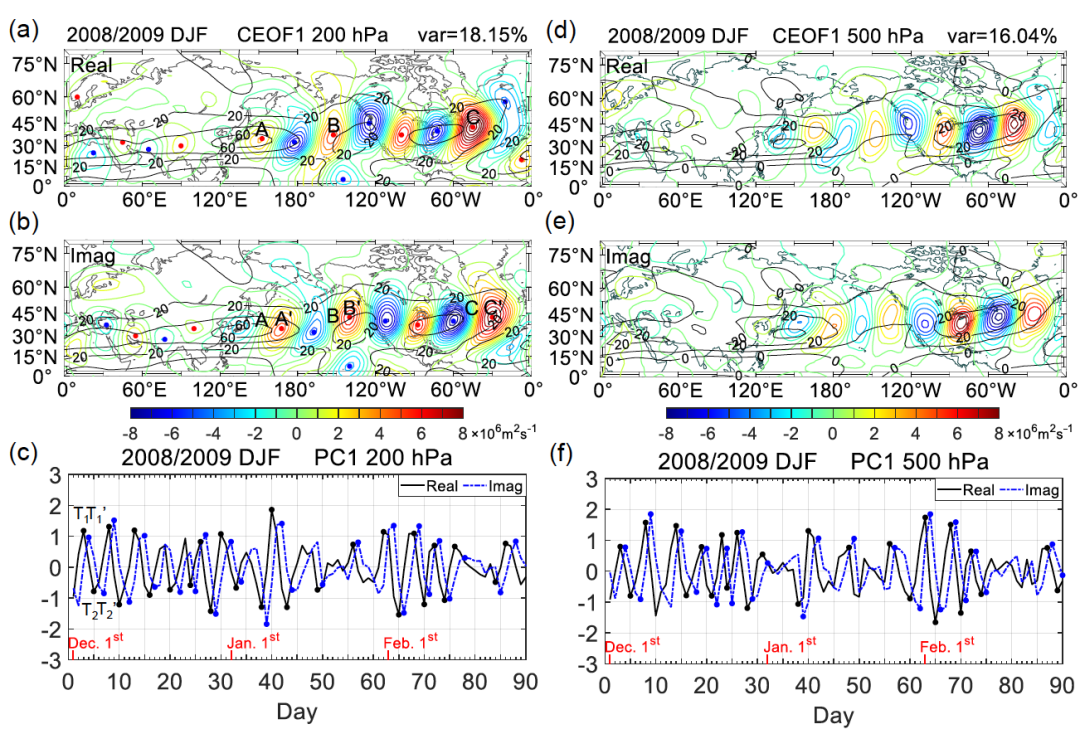Transient Rossby waves, or the large-scale eddies, play a central role in maintaining the general circulation of global atmosphere by transporting momentum, energy, and potential vorticity. There has been an unsettled debate on whether the speed of Rossby waves will be slowing down with global warming and hence leading to more severe extreme weather. The quantitative calculation of Rossby wave phase speed (RWPhS), however, is difficult due to the intrinsic dispersive nature of the Rossby waves, although the propagation of Rossby waves can be easily seen from weather charts and traditional Hovmöller diagrams.
Recently Dr. Jianhua Lu, a member of the Innovation Team for Ocean-Land-Atmosphere Interactions and Global Effects of the Southern Marine Science and Engineering Guangdong Laboratory (Zhuhai), and his student Ms. Yashu Wu developed a new method of quantitatively detecting transient RWPhS and they found that there was no evidence of slowing down of transient Rossby waves with global warming. In the new method, which is based on the Complex Empirical Orthogonal Functions (CEOFs) of bandpass-filtered daily streamfunction, the transient RWPhS can be objectively calculated by the distance between a high (or low) center in the real part of a CEOF mode and its counterpart in the imaginary part of the same CEOF mode divided by the time span between the two adjacent peaks (or bottoms) of two principal component curves for the real and imaginary parts of the CEOF mode.
Although the mean westerly jet stream at the upper troposphere doubles the speed of its counterpart at the middle troposphere, the estimated RWPhS at both levels are similar, being around 1000 km/day, quantitatively consistent with the quasi-geostrophic-theory-based RWPhS. Both observations over the past four decades and a 150-year historical simulation suggest no evidence for slowing down of the wintertime transient Rossby waves in the Northern Hemisphere. It is pointed out that the transient Rossby wave speed is determined by not only the mean flow, but also the mean meridional gradient of potential vorticity (PV). Although the mean westerly jet stream may be slowing with global warming, the offset effect between the mean flow and PV gradient leads to very small change in transient RWPhS with global warming.

Figure 1: The first mode of complex empirical orthogonal function (CEOF1) and corresponding principal component (PC1) of 2-9-day Lanczos-filtered streamfunction at 200 hPa (a-c) and 500 hPa (d-f) during December, January and February (DJF) of 2008/2009. (a) Real part and (b) imaginary part of CEOF1 (color contours, m2 s-1) and mean zonal wind speed at 200 hPa in 2008/2009 DJF (black contours, m s-1). (c) Real part (black line) and imaginary part (blue dashed line) of PC1. Dots mark the data with |PC|≥0.5). (d)-(f) Same as (a)-(c), but for 500 hPa. The criteria for the dotted centers in (a) and (b) are the absolute values larger than 1.5×106 m2 s-1.
The result from this work has been published in journal Advances in Atmospheric Sciences in February 2023, entitled “A quantitative method of detecting transient Rossby wave phase speed: No evidence of slowing down with global warming”. Dr. Jianhua Lu from the School of Atmospheric Sciences of Sun Yat-sen University and the Southern Marine Science and Engineering Guangdong Laboratory (Zhuhai) and his student Ms. Yashu Wu are respectively the corresponding author and the first author.
This study was jointly supported by the National Natural Science Foundation of China, the Southern Marine Science and Engineering Guangdong Laboratory (Zhuhai), and the Guangdong Province Key Laboratory for Climate Change and Natural Disaster Studies.
Paper link:
https://link.springer.com/article/10.1007/s00376-022-2164-5


